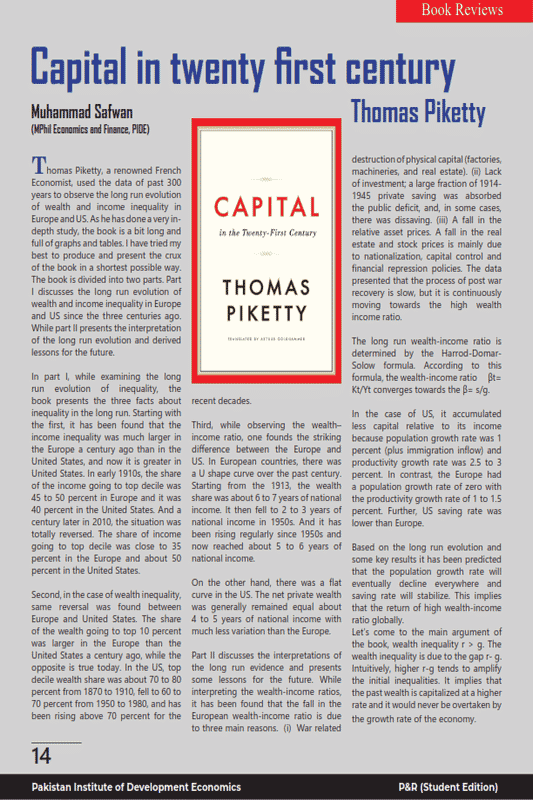Capital In Twenty First Century By Thomas Piketty (Book Review)
Thomas Piketty, a renowned French Economist, used the data of past 300 years to observe the long run evolution of wealth and income inequality in Europe and US. As he has done a very in-depth study, the book is a bit long and full of graphs and tables. I have tried my best to produce and present the crux of the book in a shortest possible way. The book is divided into two parts. Part I discusses the long run evolution of wealth and income inequality in Europe and US since the three centuries ago. While part II presents the interpretation of the long run evolution and derived lessons for the future.
In part I, while examining the long run evolution of inequality, the book presents the three facts about inequality in the long run. Starting with the first, it has been found that the income inequality was much larger in the Europe a century ago than in the United States, and now it is greater in United States. In early 1910s, the share of the income going to top decile was 45 to 50 percent in Europe and it was 40 percent in the United States. And a century later in 2010, the situation was totally reversed. The share of income going to top decile was close to 35 percent in the Europe and about 50 percent in the United States.
Second, in the case of wealth inequality, same reversal was found between Europe and United States. The share of the wealth going to top 10 percent was larger in the Europe than the United States a century ago, while the opposite is true today. In the US, top decile wealth share was about 70 to 80 percent from 1870 to 1910, fell to 60 to 70 percent from 1950 to 1980, and has been rising above 70 percent for the recent decades.
Third, while observing the wealth–income ratio, one founds the striking difference between the Europe and US. In European countries, there was a U shape curve over the past century. Starting from the 1913, the wealth share was about 6 to 7 years of national income. It then fell to 2 to 3 years of national income in 1950s. And it has been rising regularly since 1950s and now reached about 5 to 6 years of national income.
On the other hand, there was a flat curve in the US. The net private wealth was generally remained equal about 4 to 5 years of national income with much less variation than the Europe.
Part II discusses the interpretations of the long run evidence and presents some lessons for the future. While interpreting the wealth-income ratios, it has been found that the fall in the European wealth-income ratio is due to three main reasons. (i) War related destruction of physical capital (factories, machineries, and real estate). (ii) Lack of investment; a large fraction of 1914-1945 private saving was absorbed the public deficit, and, in some cases, there was dissaving. (iii) A fall in the relative asset prices. A fall in the real estate and stock prices is mainly due to nationalization, capital control and financial repression policies. The data presented that the process of post war recovery is slow, but it is continuously moving towards the high wealth income ratio.
The long run wealth-income ratio is determined by the Harrod-Domar- Solow formula. According to this formula, the wealth-income ratio βt= Kt/Yt converges towards the β= s/g.
In the case of US, it accumulated less capital relative to its income because population growth rate was 1 percent (plus immigration inflow) and productivity growth rate was 2.5 to 3 percent. In contrast, the Europe had a population growth rate of zero with the productivity growth rate of 1 to 1.5 percent. Further, US saving rate was lower than Europe.
Based on the long run evolution and some key results it has been predicted that the population growth rate will eventually decline everywhere and saving rate will stabilize. This implies that the return of high wealth-income ratio globally.
Let’s come to the main argument of the book, wealth inequality r > g. The wealth inequality is due to the gap r- g. Intuitively, higher r-g tends to amplify the initial inequalities. It implies that the past wealth is capitalized at a higher rate and it would never be overtaken by the growth rate of the economy.
The gap r-g remained high during the past 3 centuries. With the annual return on capital, on average remained 4 to 5 percent and the growth rate 1 to 1.5 percent. It is predicted that the population growth will slow down in the twenty first century. And the after tax return to capital will rise due to rising international tax competition to attract the capital. It is likely that r-g will increase in the 21st century.
Finally, the income inequality has also an interesting interpretation. This is the combination of capital income and labor income. Simon Kuznets said that the income inequality is due to the economic development, such as the industrial revolution. Initially when the small number of people joins the development process, income inequality increases. And after a period of time when other workers join the high paying sector it decreases. But data in the book shows that this is not the reason why income inequality has decreased. In twentieth century, the fall of the income inequality is because of the fall in top capital incomes, induced by wars, Great depression and fiscal policies adopted by the developed countries.




